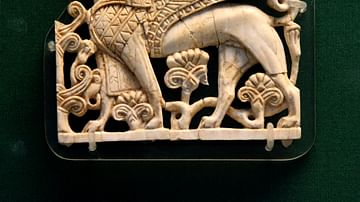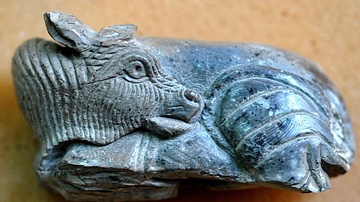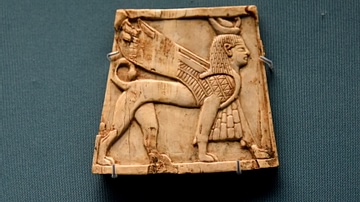Search
Remove Ads
Advertisement
Summary 
Loading AI-generated summary based on World History Encyclopedia articles ...
Search Results

Article
Wall Reliefs: Apkallus of the North-West Palace at Nimrud
Religion is the sigh of the oppressed creature, the heart of a heartless world, and the soul of soulless conditions. It is the opium of the people. (Karl Marx, Critique of Hegel's Philosophy of Right). When it comes to religion, many people...

Article
The Nimrud Dogs
The Nimrud Dogs, five canine figurines found at the ancient Mesopotamian city of Nimrud, were only a few of the many startling finds in the region during the 19th century when expeditions were sent to corroborate biblical narratives through...

Article
The Nimrud Ivories: Their Discovery & History
In 1845 CE, the archaeologist Austen Henry Layard began excavations at the ruins of the city of Nimrud in the region which is northern Iraq in the present day. Layard's expedition was part of a larger movement at the time to uncover ancient...

Definition
Kalhu / Nimrud
Kalhu (also known as Caleh, Calah, and Nimrud, in modern-day northern Iraq) was a city in ancient Mesopotamia that became the capital of the Assyrian Empire under Ashurnasirpal II (r. 884-859 BCE) who moved the central government there from...

Image
Nimrud Ivory Supine Bull
An exquisitely carved plaque of a supine bull. Note the black burn mark. Probably, this was part of a group which once supported an ivory tray. Neo-Assyrian period, 9th-7th centuries BCE. From Nimrud, Mesopotamia, Iraq. (The Sulaimaniya Museum...

Image
Nimrud Ivory Panel of a Winged Sphinx
Never seen by the public before 2011. A small fragment of an ivory plaque from Nimrud. This winged-sphinx is Egyptian and wears the double crown of Egypt as well as a chest apron, the typical royal costume of Egyptian pharaohs. Phoenician...

Image
Nimrud Ivory Panel of a Winged Animal
Never seen by the public before 2011. A small fragment of an ivory plaque from Nimrud. The panel shows a winged 4-legged animal (mythical creature). Phoenician art. Neo-Assyrian Period, 9th to 8th centuries BCE. From Nimrud (ancient Kalhu...

Image
Nimrud Ivory Panel of Two Lionesses
Never seen by the public before 2011. A small fragment of an ivory plaque from Nimrud. On the ivory plaque, there are 2 carved roaring lionesses facing each other. Neo-Assyrian Period, 9th to 8th centuries BCE. From Nimrud (ancient Kalhu...

Image
Nimrud Ivory Panel of a Suckling Calf
Never seen by the public before 2011. A small fragment of an ivory plaque from Nimrud. A standing cow turns her head towards a small calf. The calf appears to suckle milk from the cow's nipples. Neo-Assyrian Period, 9th to 8th centuries BCE...

Image
Nimrud Ivory Panel of Tawaret
Never seen by the public before 2011. A small fragment of an ivory plaque from Nimrud. Two figures of the Egyptian goddess Tawaret (the demon-wife of Apep and the first god of evil) can be seen. Phoenician art. Neo-Assyrian Period, 9th to...